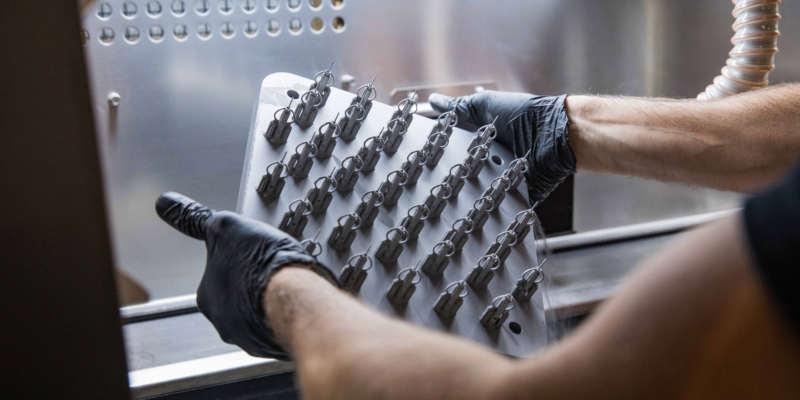Digital manufacturing service bureau Protolabs is extending its operations into the oil and gas sector. After securing a DNV ‘Qualification of Manufacturer’ certification, the company is now aiming to push its metal 3D printing services for the production of oil and gas parts. This makes Protolabs the first metal additive manufacturing (AM) provider in Europe to obtain the certification.
The company is based in Minnesota, but has operations in England, Germany, and Japan. Its European headquarters in Telford achieved the certification for its laser powder bed fusion process for Inconel 718 parts. Due to the metal superalloy’s high strength and corrosion resistance, this version of nickel chromium is ideal for applications in the oil and gas sector, where parts come into regular contact with corrosive materials.
The certification came after an audit of its manufacturing facilities and processes by DNV, the world’s largest classification society. DNV has played a crucial role in certifying 3D printing parts and processes in oil and gas, as well as the maritime sector.
“The DNV certification applies to our Inconel 718 capability, but we see it as testament to our ongoing quality processes and expect to see that trust extended to our whole offering. I believe the sector will turn to additive technologies to replace what was formerly cast, whilst also looking into design possibilities to increase efficiency and create more robust designs for parts including pumps, valves and components for turbines,” Daniel Cohn, General Manager and 3DP Lead for Protolabs EMEA, said. “Importantly, the certification assures customers that they can use the additive manufacturing route to unlock decarbonisation benefits. Additive manufacturing can grow even faster if there is trust in the technology, materials, processes and in the manufacturing companies who deliver the services.”
As detailed in “The Market for Additive Manufacturing in the Oil and Gas Sector 2018-2029” report from SmarTech Analysis, 3D printing for the oil and gas sector is one that is still little explored. The report notes that just a handful of key players are currently targeting what is projected to be a $2 billion opportunity by 2029. DNV, which sits as the entry point for many additive providers to have their technologies certified for the oil and gas companies, is pitching 3D printing as means to decarbonization.
This idea, echoed by Cohn above, is that 3D printing is more energy efficient and less wasteful than subtractive manufacturing. The certification society also highlights the energy reductions possible if parts are 3D printed closer to their point-of-use, thus cutting transportation emissions and energy requirements.
The former point about energy use is still up for debate, with the Additive Manufacturer Green Trade Association determining that 3D printing can reduce the emissions of aircraft through light-weighting, but that LPBF metal 3D printers can have higher carbon footprints per kilogram of material processed than conventional manufacturing. The organization also concluded that electrical energy intensity of AM generally was one to two orders of magnitude higher than conventional machining and injection molding, while processing speeds were three orders of magnitude smaller. As to the second point, distributed manufacturing is an interesting paradigm that could see reductions in greenhouse gas emissions associated with transportation, but that paradigm has not yet come to pass.
So, to call 3D printing a “[route] to reduce emissions from oil and gas production” or lean on it for decarbonization seems misleading at the least and greenwashing at the worst. It has the potential to offer some benefits in terms of design efficiency but is still just another energy-using tool. In this case, it is a tool that will be exploited by oil and gas majors for greater efficiency, allowing them to draw out even more fossil fuels from the Earth, a form of Jevons Paradox. In contrast, what really needs to happen to decarbonize is to shift to other modes of energy production and decrease production and consumption in industrial societies.
Perhaps some headway is being made on that front, as the International Energy Agency has issued a report concluding that new investment in fossil fuel production needs to be brought to a halt if humanity is to limit global warming to 1.5°C above pre-industrial levels—and thus stave off the most catastrophic effects of climate change. This supports European Commission efforts to end EU funding for oil and gas projects.
As the large bureaucracies attempt to issue these measures, numerous campaigns to push institutional divestment from fossil fuels are beginning to succeed, with faculty at the University of Albany calling for their pension funds to give up fossil fuels, the University of Utah facing pressure from their student academic body, and 36 faith institutions from 11 countries claiming that they will no longer invest in fossil fuels. Whether it will be fast and powerful enough to take on the speed of commerce is another story.
Subscribe to Our Email Newsletter
Stay up-to-date on all the latest news from the 3D printing industry and receive information and offers from third party vendors.
You May Also Like
Precision at the Microscale: UK Researchers Advance Medical Devices with BMF’s 3D Printing Tech
University of Nottingham researchers are using Boston Micro Fabrication‘s (BMF) 3D printing technology to develop medical devices that improve compatibility with human tissue. Funded by a UK grant, this project...
3D Printing Webinar and Event Roundup: April 21, 2024
It’s another busy week of webinars and events, starting with Hannover Messe in Germany and continuing with Metalcasting Congress, Chinaplas, TechBlick’s Innovation Festival, and more. Stratasys continues its advanced training...
3D Printing Webinar and Event Roundup: March 17, 2024
It’s another busy week of webinars and events, including SALMED 2024 and AM Forum in Berlin. Stratasys continues its in-person training and is offering two webinars, ASTM is holding a...
3D Printed Micro Antenna is 15% Smaller and 6X Lighter
Horizon Microtechnologies has achieved success in creating a high-frequency D-Band horn antenna through micro 3D printing. However, this achievement did not rely solely on 3D printing; it involved a combination...































